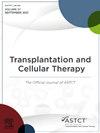异体血液或骨髓移植后环磷酰胺免疫抑制水平和移植物抗宿主病风险的评估
IF 4.4
3区 医学
Q2 HEMATOLOGY
引用次数: 0
摘要
移植后环磷酰胺(PTCy)是同种异体血液或骨髓移植(allogeneic blood or marrow transplantation, alloBMT)的标准移植物抗宿主病(GVHD)预防药物,尽管免疫抑制(is)联合PTCy的最佳治疗水平仍存在争议。以前,在他克莫司和甲氨蝶呤预防GVHD的治疗中,第1周他克莫司水平bbb12 ng/mL与2-4级急性GVHD (aGVHD)发生率降低相关。我们评估了在接受PTCy治疗的患者中是否观察到aGVHD和早期IS水平之间的关联。这项回顾性单中心研究包括349名患者,他们在2017年9月1日至2019年9月30日期间接受PTCy和霉酚酸酯,同时服用他克莫司(n=185)或西罗莫司(n=164)。接受他克莫司和西罗莫司治疗的患者中位年龄分别为58岁和54岁。两个队列的主要诊断疾病是急性髓性白血病、急性淋巴细胞白血病、骨髓增生异常综合征和淋巴瘤。大多数接受他克莫司的患者来自骨髓移植(78.4%),而大多数接受西罗莫司的患者来自外周血(80.5%)。所有患者均以fluytbi作为调理方案进行移植。主要终点是在异源bmt后150天2-4级aGVHD发生率本文章由计算机程序翻译,如有差异,请以英文原文为准。
Evaluation of Immunosuppression Levels and Risk of Graft-Versus-Host Disease in Allogeneic Blood or Marrow Transplantation With Post-Transplantation Cyclophosphamide
Post-transplantation cyclophosphamide (PTCy) is standard graft-versus-host disease (GVHD) prophylaxis for allogeneic blood or marrow transplantation (alloBMT), although optimal therapeutic levels of immunosuppression (IS) therapy combined with PTCy remain contested. Previously, with tacrolimus and methotrexate GVHD prophylaxis, week 1 tacrolimus levels >12 ng/mL were associated with a decreased incidence of grade 2 to 4 acute GVHD (aGVHD). We evaluated if associations between aGVHD and early IS levels were observed amongst patients receiving PTCy. This retrospective single-center study consisted of 349 patients who received PTCy and mycophenolate mofetil, with either tacrolimus (n = 185) or sirolimus (n = 164) from September 1, 2017, to September 30, 2019. The median age of patients receiving tacrolimus and sirolimus were 58 and 54 years, respectively. The primary diagnosed diseases for both cohorts were acute myeloid leukemia, acute lymphoblastic leukemia, myelodysplastic syndrome, and lymphoma. While most patients receiving tacrolimus were bone marrow graft sourced (78.4%), the majority of patients receiving sirolimus were peripheral blood sourced (80.5%). All patients were transplanted with FluCyTBI as the conditioning regimen. The primary outcome was grade 2 to 4 aGVHD incidence at 150 days post alloBMT between weekly IS levels <10 ng/mL versus ≥10 ng/mL throughout the 4 weeks post-alloBMT. Secondary endpoints included moderate to severe chronic GVHD (cGVHD) incidence, median overall survival (OS), relapse-free survival (RFS), and GVHD-free relapse-free survival (GRFS) at 2 years and the correlation between weekly IS levels <10 ng/mL versus ≥10 ng/mL throughout 4 weeks post-alloBMT. Patients receiving tacrolimus were compared to others in the tacrolimus cohort, and similarly for sirolimus. No correlation was found between IS levels at any individual week and cumulative aGVHD incidence for either tacrolimus or sirolimus. In the sirolimus cohort, no correlation for moderate to severe cGVHD was observed. However, at week 4, patients in the tacrolimus cohort with levels ≥10 ng/mL experienced significantly higher incidence of moderate to severe chronic GVHD than patients with weekly levels <10 ng/mL (20% versus 8%, P < .001). When evaluating survival outcomes, post-alloBMT week 1 tacrolimus levels ≥10 ng/mL were associated with decreased OS (HR 3.84, 95% CI [1.16 to 12.67]; P = .027), but no correlation was seen in RFS (HR 1.62, 95% CI [0.56 to 4.72]; P = .377), or GRFS (HR 1.56, 95% CI [0.89 to 2.74]; P = .124). Post-alloBMT week 1 sirolimus ≥10 ng/mL levels were associated with decreased OS (HR 2.74, 95% CI [1.37 to 5.48]; P = .004) and GRFS (HR 1.93, 95% CI [1.19 to 3.12]; P = .007), but not RFS (HR 1.60, 95% CI [0.78 to 3.30]; P = .202). Overall, early IS levels in patients receiving PTCy-based GVHD prophylaxis did not correlate with aGVHD incidence, although IS levels ≥10 ng/mL were associated with compromised outcomes. Targeting IS levels <10 ng/mL may be optimal when using PTCy-based GVHD prophylaxis.
求助全文
通过发布文献求助,成功后即可免费获取论文全文。
去求助
来源期刊

Transplantation and Cellular Therapy
Medicine-Hematology
CiteScore
7.00
自引率
15.60%
发文量
1061
审稿时长
51 days
 求助内容:
求助内容: 应助结果提醒方式:
应助结果提醒方式:


